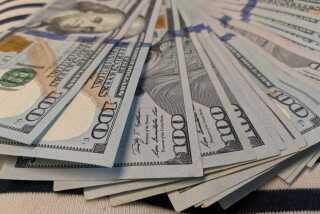$10 Billion Dumped Early in Year to Depress Dollar
- Share via
NEW YORK — The United States and 10 allies dumped about $10 billion on foreign exchange markets between Jan. 21 and March 1, one of the largest coordinated interventions against the dollar since foreign exchange rates began floating in 1973, the Federal Reserve Bank of New York said Friday.
The disclosure was made in the Federal Reserve Board’s semiannual report to Congress on its foreign exchange operations. It provided the government’s first confirmation of the size of the joint intervention that helped halt the dollar’s record-breaking rise last winter.
The U.S. share of the operation, as previously disclosed, was $659 million over the five-week period. That was the largest U.S. intervention since early 1981, during the beginning months of the Reagan Administration.
In February and March, 1981, the United States bought the equivalent of $778.4 million in West German marks when the dollar was rising sharply in volatile trading. The United States later sold the equivalent of $74.4 million in marks to support the dollar and calm markets after an unsuccessful assassination attempt against President Reagan on March 30.
In the late 1970s, U.S. intervention was substantially higher.
When central bankers intervene against the dollar, they sell dollars and buy other currencies. The sudden flood of dollars on the market, combined with increased demand for other currencies and the psychological impact when it becomes clear that central bank action is being launched against a specific currency, usually is enough to halt a precipitous rise by the dollar.
Analysts have said, however, that intervention alone usually is not enough to reverse the course of a currency.
Under the Reagan Administration, intervention has been limited to countering conditions of disorder in foreign exchange markets. Disorderly conditions have never been precisely defined, giving the Fed and the Treasury some leeway in their operations.
In addition, at a January financial summit of officials from the United States, Japan, West Germany, Britain and France, the United States agreed to intervene with others when it is “helpful.”
Complaints From Allies
Allies had complained that the surge in the dollar since 1980 drained investment capital from their economies as investors sought the attractive returns and relative safety of dollar-denominated holdings. Allies also complained of increased import expenses for oil and other commodities sold for dollars.
At the same time, however, the rising dollar gave foreign manufacturers a price edge when competing with goods made in the United States, a condition that has created record U.S. foreign trade deficits in recent years.
Sam Y. Cross, executive vice president of the New York Fed bank and author of the report, confirmed Friday that U.S. intervention policy had not changed after a June meeting in Tokyo of ministers from the United States, Belgium, Britain, Canada, France, Italy, Japan, the Netherlands, Sweden, Switzerland and West Germany--known as the G-10 countries.
In general, currency traders view disorderly conditions as periods of wide swings in exchange rates without consistency in bids between dealers.
At All-Time Highs
Such was the case early this year as the dollar began a climb that by late February had lifted it to all-time highs against the currencies of Britain, Canada, France and Italy, 13-year highs against the Dutch guilder and West German mark and a 10-year peak against the Swiss franc.
After the finance ministers’ meeting in January, concerted intervention against the dollar was launched by the G-10 countries, with the heaviest sales of dollars occurring between Feb. 27 and March 1, after the dollar had peaked.
“For all G-10 countries as a group, the total of dollars sold during the five weeks between Jan. 21 and March 1 was about $10 billion,” the Fed report said. “This series of operations constituted one of the biggest dollar interventions during the floating-rate period.”
Margaret Greene, a senior vice president for foreign exchange operations at the New York Fed bank, said the $10-billion intervention over a five-week period was one of the largest for such an interval since 1973. But, she added, for the entire six-month reporting period, the intervention “was not exceptional.”
The Fed said the sales of dollars by G-10 countries other than the United States early this year “was large enough to cause a sizable drop in their official foreign currency reserves.” But the report also said that foreign central banks took advantage of a sharp decline in the dollar after February to rebuild foreign currency reserves by the end of June.
No Further Intervention
The Fed said there was no other intervention through the end of July, the period covered by the report. Outside of the formal reports, the Fed does not comment on its currency operations.
The Fed said that after the concerted intervention, the dollar was weakened by a more pessimistic assessment of the outlook for the U.S. economy and strains on U.S. financial markets, including a crisis that temporarily closed 70 Ohio savings and loan associations and the collapse of three government securities dealers.
Through Friday, the Fed’s trade-weighted index measuring the dollar against the currencies of 10 other industrial countries has fallen 13.6% since reaching an all-time high on Feb. 25. But it is up 4.9% from Aug. 21, its low point of the year.
More to Read
Inside the business of entertainment
The Wide Shot brings you news, analysis and insights on everything from streaming wars to production — and what it all means for the future.
You may occasionally receive promotional content from the Los Angeles Times.









